This is my favorite pierogi dough recipe – soft, elastic, smells of butter and is easy to roll out. This is the best pierogi dough recipe you’ll find. Below I’m also sharing many tips on how to make the perfect pierogi and answer all the questions you could have.
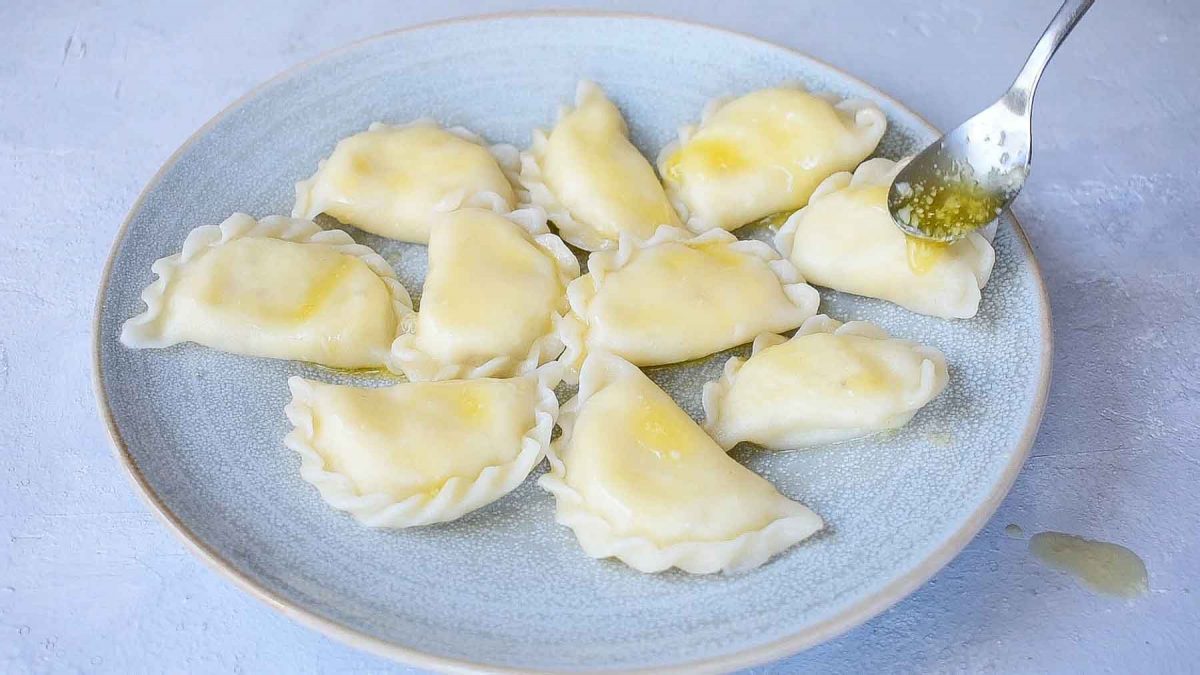
What are pierogi/pierogies?
Pierogi are Polish dumplings, made with unleavened dough and filled with sweet or savory fillings. They are boiled and then sometimes additionally pan-fried.
Pierogi in Poland:
Pierogi are one of the most popular Polish dishes. They are served as a main dish or as a side dish. The most popular pierogi are potato and cheese pierogi, sauerkraut and mushroom pierogi, and pierogi with meat filling (at least in the region where I’m coming from). In summer sweet pierogi (filled with fruits, like strawberries and blueberries) are popular. The flavor combinations are countless.
In Poland you can find small restaurants, where only pierogi are being served, they are filled with many different fillings. Such a restaurant is called ‘pierogarnia’.
Pierogi, Pierogies or Perogies?
Although the word ‘pierogies’ is popularized in English-speaking countries, it is not the true name of these Polish dumplings. The correct name is: singular – 1 pieróg and plural – pierogi. There are no other terms to name it.
What is the difference between pierogi and ravioli:
Ravioli are Italian dumplings, that are wrapped in pasta dough (this dough must contain eggs and is more rich and tough). Italian fillings also differ from traditional pierogi fillings.
Top tips for making the perfect pierogi dough:
- Traditional pierogi dough is easy to make without a recipe (I think no Polish grandmother makes it with a recipe, at least both my grandmothers don’t). The exact recipe is not important here, if the dough is too dry, you need to add some water, if too wet – a little bit of flour. However, it is worth having your favorite recipe and a kitchen scale on hand – the preparation goes much faster, the ingredients are added into a bowl and kneaded together, you don’t need to add additional water or flour.
- One of the most important things is, that the dough is well-kneaded!
- After kneading the dough, let it rest. You can see on my video how much softer and pliable the dough is after it has rested.
- Best water temperature – very hot but not boiling.
- Add some fat – it can be butter (more flavor) or oil.
- Don’t add eggs to the dough (more on that below).
- Dough to filling ratio: it’s very important, but it’s also a matter of taste. I like it when my dough is not very thin but also not very thick. I like to stuff my pierogi with lots of filling but I also like to taste the dough. Experiment what works best for you.
Easy pierogi dough ingredients:
- The best flour to make pierogi – I’m using all-purpose flour.
- Water – it’s important to add hot water to the dough. It makes the dough soft and pliable. You should warm the water with butter until they are very hot, but not boiling (temperature around 80-90 °C / 176-194 °F, that is when the water starts to move and steam). Too hot water will make the dough a little bit more chewy and sticky. Cold water will make the dough harder to roll out and it will be more difficult to shape the pierogi.
- Fat – you could make the dough without it, but it really makes the dough perfect. I’m using butter for its taste but any vegetable oil will also work.
- Salt – also the dough should be seasoned, not only the filling.
- I’ve seen some recipes that call for sour cream. Personally, I’ve never heard of such pierogi dough ingredient and don’t know anyone who is making pierogi with it (at least in Poland). I think it’s more an American or Russian/Ukrainian ingredient. Nowadays though, many home cooks experiment with the ingredients. Authentic Polish pierogi dough recipe call just for flour, water, salt, and optionally some fat and an egg.
Pierogi dough with egg or no egg:
There are two ways of making the pierogi dough – with or without an egg. Many Polish home cooks are arguing, which way is the best.
For me, the perfect pierogi dough is made without the egg. The dough with eggs is a bit tougher in my opinion, but the difference with a well-kneaded dough is not that huge (but there is a difference).
The second reason why I don’t add an egg is that it’s more hygienic – having a small child at home, I usually make a lot of pierogi in one batch, but making a lot of breaks in between. I do not have to worry about washing my hands thoroughly all the time, taking care if the table is well cleaned and watching out if my daughter is eating a dough with a raw egg.
By the way, you should try making pierogi with your kids. Rolling out the dough, cutting out rounds, shaping the pierogi – I think it’s a fascinating activity for every child!
Since this pierogi dough is made without eggs it is suitable for vegetarian diet, vegan diet or dairy-free diet (swap the butter for vegetable oil), or egg-free diet.
What equipment do you need:
- I love making my pierogi dough in my Kitchen Aid but you can also make it by hand. You’ll need to knead the dough for about 10 mins. A food processor can also be used (fitted with the dough blade), but I prefer the stand mixer.
- A rolling pin (or alternatively a wine bottle!). For rolling out the dough you can use a pasta maker (I’m sometimes using my Kitchen Aid pasta attachment). I find that it’s equally easy to roll out the dough by hand and with the pasta maker. Pierogi dough is much more pliable and soft in comparison to pasta dough, which makes it easier to roll out by hand.
- Pierogi cutter / pastry cutter / a cup (preferably with sharp edges). I prefer to use a real pierogi cutter or a pastry cutter – it’s easier to cut out rounds. A regular glass/cup can also be used but I find cutting out round a little bit harder as its edges are more thick and blunt. It would be better to use a glass that has thin, sharp edges if you don’t have a pierogi cutter (both my grandmas are using a regular glass though ;)).
- A pot to cook the pierogi (obviously) and a slotted spoon.
- There are pierogi maker press or pierogi molds available if you search online. I haven’t personally tried them out. Feel free to let me know if there are any that you really like!
How to make pierogi dough – step by step:
STEP 1: Add flour and salt to a large bowl.
STEP 2: Add hot water with butter.
STEP 3: Mix with a wooden spoon until roughly combined.
STEP 4: Knead the dough until smooth and soft.
STEP 5: Prepare the filling.
STEP 6: Roll out the dough and cut out the rounds.
STEP 7: Place the filling on the round.
STEP 8: Shape the pierogi. Ready to be cooked!
How to measure the flour:
In the recipe card below, I provided all possible measurements for the pierogi dough – by volume and by weight. I’m always using a kitchen scale to make my pierogi (and generally to develop the recipes on my website). If you’re weighing your ingredients on a scale your results will be very consistent and the same as mine. It’s really easier, quicker and a kitchen scale is super cheap!
If you’re measuring the flour with measuring cups there is a possibility that you will add more or less flour than I did. You need to check the consistency of the dough and add more flour if it’s too wet and more water if it’s too dry and too tough.
Measuring the flour with measuring cups is unfortunately very inaccurate. 1 US cup of flour can weigh from 120g-140g, depending on how you fill the cup. 20g is a little over 2 tablespoons of flour, so when this recipe calls for 4 cups of flour, you could have added 8 tablespoons more flour which is 1/2 cup! For measuring flour I’m spooning the flour into the measuring cup with a tablespoon and not scooping it with the cup. Level the flour with the back of the knife and don’t tap the cup or press down the flour. Read this article for more information on how to measure flour.
1 US cup is 240 ml. An European cup is 250 ml!
How to roll out the dough with a pasta maker:
Pierogi dough can also be rolled out using a pasta machine. I have a Kitchen Aid pasta roller attachment. I roll out the dough on setting 4. According to the manufacturer’s instructions you need to roll out the dough on each setting until you get to the setting 4. I’m not doing this, pierogi dough without an egg is easier to roll out than an egg dough or pasta dough. To make it possible, the dough must be well sprinkled with flour, at room temperature, slightly rolled out with a rolling pin (to a thickness of approx. ¾ cm / ½ inch) and smooth (otherwise will tear).
How to store pierogi:
To ensure that the cooked pierogi don‘t stick to each other, brush them lightly with melted butter or oil. Store in a tightly-closed container in the fridge for about 2 days. On the next day, it‘s best to pan-fry them with butter until golden.
Freshly cooked pierogi taste best for me, so I usually do this: I prepare only the amount of dumplings that we are going to eat on a given day (about 14 per person, my pierogi are rather small, see the video for the reference). I wrap the rest of the dough tightly in plastic foil and put it in the fridge. I place the rest of the filling (or make filling balls from all of the filling) and also tightly wrap in plastic foil and put in the fridge. On the next day (or even on the third day) I’m preparing the rest of the pierogi.
If I have more time and I’m making more pierogi in one batch, I freeze them or pan-fry with butter the next day.
After removing the dough from the fridge, it is good to slightly warm it up (leave it for about 15-30 minutes on the counter), it will be more elastic (this is optional). The next day the dough can look a little gray in color, but we don‘t mind that.
Freezing tips:
- Cooked pierogi: Place the pierogi apart on a tray, sprinkled well with flour. Freeze until solid. Transfer to containers on plastic bags. Cook like fresh pierogi but take them out once they float on the water surface.
- Uncooked pierogi: Note that not boiled raw pierogi are more likely to crack in a freezer than cooked pierogi. I most often freeze raw pierogi though. Place the pierogi on a tray / wooden board sprinkled well with flour (important, dumplings can easily stick to the tray and tear). Arrange the dumplings so that they do not touch each other. When frozen, transfer them into containers or plastic bags. I cook frozen dumplings just like fresh ones, with the difference that you can cook a smaller amount of them at a time, I cook max. 7-8 frozen pierogi at once (and about 10-12 fresh). When you drop too many frozen pierogi at once it will lower the temperature of the water too much and they will burst.
Store-bought frozen pierogi:
I’ve never eaten store-bought frozen pierogi that tasted amazing (maybe I’m just spoiled with homemade pierogi!). In terms of taste, some of them were not that bad, but for me, the dough is always too thick. This is not surprising since these pierogi are not made by hand. The dough manufactured in a factory need to be thicker so it won’t easily break and can be filled by a machine. Homemade pierogi all the way!
FAQ:
Knead the dough well then let it rest before rolling it out. A good recipe is also important – add butter and hot (but not boiling) water to the dough.
Toss the hot, freshly cooked pierogi with butter or oil until coated on all sides.
You can freeze cooked pierogi or uncooked pierogi. See the instructions above.
There’s no need to do that. You can throw frozen pierogi direct into boiling water.
I like to keep it simple and just pour melted butter over them. Other options are: sauteed/caramelized onions, pan-fried bacon, chopped parsley. Sweet pierogi are often served with sweetened heavy cream/sour cream.
Here you’ll find all my pierogi sauces and toppings ideas.
Yes! You can wrap the filling in shortbread pastry and bake until golden. This kind of pierogi is not that popular but in some regions, people are making baked pierogi.
Your dough was probably not evenly rolled out. Thicker pierogi will be a bit bigger, also when you fill them with more filling. If the dough is of the same thickness you can cook the small and big pierogi the same way.
Cut it into thick strips and use as pasta eg with soup.
It’s probably not well-kneaded, not rested or you’ve used cold water. It’s also possible that you’ve added too much flour – add more water until the dough is smooth and soft.
It really depends on your preferences. I really dislike dough that is rolled out too thick. When the dough is thinly rolled out it literally melts in your mouth after you cook the pierogi.
It will take a minimum of 5 minutes by hand and about 3 minutes in a stand mixer. It can take longer or shorter. You need to pay attention to the dough’ consistency – it should be smooth and soft (check out the video to see the consistency of the dough). It will be even softer when it’s rested.
The dough can be too elastic and shrink as you try to roll it out when it’s not rested. Make sure to rest the dough for about 20-30 minutes, then it should be easy to roll out. This is caused by gluten that is in every type of wheat flour.
Filling recipes:
I have a separate post, where I talk about all the traditional and modern pierogi filling ideas.
Here are the written recipes:
- authentic potato and cheese pierogi (pierogi ruskie) – with potato, twaróg cheese, and onion filling
- potato and cheese pierogi the American way (cheddar pierogi)
- sauerkraut and mushroom pierogi
- spinach and feta pink pierogi (basic pierogi dough is colored with beetroot juice!) with potatoes, onion, feta cheese, and spinach filling
- vegan/vegetarian pierogi with spicy lentil and sun-dried potato filling
- uszka (‘little ears’) pierogi – porcini (wild mushroom) filled mini pierogi for Christmas Eve Borscht
- sweet cheese pierogi
The best pierogi dough recipe + how to make perfect pierogi
Ingredients
- 4 cups flour 500g / 17.5-oz, spoon and leveled, all-purpose flour
- 1 cup + 2.5 Tbsp water 280g / 280ml / 10-oz (to weight on a scale)
- 3 tablespoons butter 1.4 oz/40g, or vegetable oil
- 1 teaspoon salt
Would you like to save this?
Instructions
→ Make the dough:
- Add the flour and salt into a large bowl, mix together.
- In a small saucepan, warm the water with butter until they are very hot, but not boiling (temperature should be around 80-85 °C / 176-185 °F, that is when the water starts to move and steam).
- Pour hot water with butter into the bowl with flour, mix with a wooden spoon until roughly combined.
- Knead the dough using your hands or with a stand mixer fitted with a hook attachment, for about 5 minutes. A food processor can also be used (fitted with the dough blade). The dough should be smooth, soft, and elastic, it shouldn’t stick to your hands. When you follow the recipe (especially if you weigh the ingredients, instead of using measuring cups), the dough should be perfect, but if for some reason it’s not, add some water if it’s too dry, or a little bit of flour if it’s too wet. If the dough already forms a ball, is relatively smooth, but still tough, it means that it’s not ready, it must be further kneaded until soft and elastic (after resting time it will be even softer).
- Wrap the kneaded dough in plastic foil (so it doesn’t dry out), leave to rest for about 30 minutes (it will be easy to roll out).
→ Rolling out, stuffing and shaping the pierogi:
- Divide the dough into 4 parts.
- Onto a lightly floured surface, roll out thinly the first piece of the dough, to a thickness of approx. 2 mm / 1/16 inch. If the dough is hard to roll out, set it aside for about 5-10 minutes to rest.
- Use a cup or a pierogi/pastry cutter to cut out rounds. Place one ball of filling / 1 teaspoon of filling on each round.
- Gather scraps, cover with plastic wrap and set aside.
- Fold the dough over the filling to create a half-moon shape. Press edges together, sealing and crimping with your fingers. Do not leave any gaps or pierogi may open during cooking.
- Place the pierogi apart on a towel lightly sprinkled with flour (this is important, they can stick to the board), cover loosely with a kitchen cloth so that they don‘t dry out.
- Repeat with the remaining dough.
-> Cook the pierogi:
- Bring a large pot of salted water to a boil.
- Cook the pierogi in batches (for a 21 cm /8-inch pot I cook about 10-12 dumplings at a time). When they float to the water surface cook them for 1-2 minutes, then remove from the water with a slotted spoon. The cooking time will depend on the thickness of the dough.
- Drain well and transfer onto a plate. Serve warm, pour over some melted butter.
- Enjoy!
Notes
To ensure that the cooked pierogi don‘t stick to each other, brush them lightly with melted butter or oil. Store in a tightly-closed container in the fridge for about 2 days. On the next day, it‘s best to pan-fry them with butter until golden.
Freshly cooked pierogi taste best, so I usually do this: I prepare only the amount of pierogi that we are going to eat on a given day (about 14 per person). I wrap the rest of the dough tightly in plastic foil and put it in the fridge. I place the rest of the filling (or make filling balls from all of the filling) and also tightly wrap in plastic foil and put in the fridge. On the next day (or even on the third day) I’m preparing the rest of the pierogi. If I have more time and I’m making more pierogi in one batch, I freeze them or pan-fry then with butter the next day.
After removing the dough from the fridge, it is good to slightly warm it up (leave it for about 15-30 minutes on the counter), it will be more elastic (this is optional). The next day the dough will be a little gray in color, but we don‘t mind that. – How to freeze pierogi: Cooked pierogi: Place the pierogi apart on a tray that is sprinkled well with flour. Freeze until solid. Transfer to containers on plastic bags. Cook like fresh pierogi but take them out once they float to the water surface. Uncooked pierogi: Note that not boiled raw pierogi are more likely to crack in a freezer than cooked pierogi. I most often freeze raw pierogi though. Place the pierogi on a tray / wooden board sprinkled well with flour (important, dumplings can easily stick to the tray and tear). Arrange the dumplings so that they do not touch each other. When frozen, transfer them into containers or plastic bags. I cook frozen dumplings just like fresh ones, with the difference that you can cook a smaller amount of them at a time, I cook max. 7-8 frozen pierogi at once (and about 10-12 fresh). When you drop too many frozen pierogi at once it will lower the temperature of the water too much and they will burst. – Rolling out with pasta machine: I have a Kitchen Aid pasta roller attachment. I roll out the dough on setting 4. According to the manufacturer’s instructions you need to roll out the dough on each setting until you get to the setting 4. I’m not doing this, pierogi dough without an egg is easier to roll out than an egg dough or pasta dough. To make it possible, the dough must be well sprinkled with flour, at room temperature, slightly rolled out with a rolling pin (to a thickness of approx. ¾ cm / ½ inch). and smooth (otherwise will tear). – 1 cup is 240 ml. – The amount of pierogi: based on the feedback that I got from readers, the amount of pierogi you’ll get from this recipe can vary greatly! My pierogi are rather small and I like to pack them with a lot of filling, that’s why I got 100 pierogi from this recipe. This may be different for you and you can get only half of this amount.
Did you make this recipe? RATE THE RECIPE or tell me in the COMMENTS how you liked it! You can also add a photo of your dish. It would make me very happy and will help other readers. Thank you!!


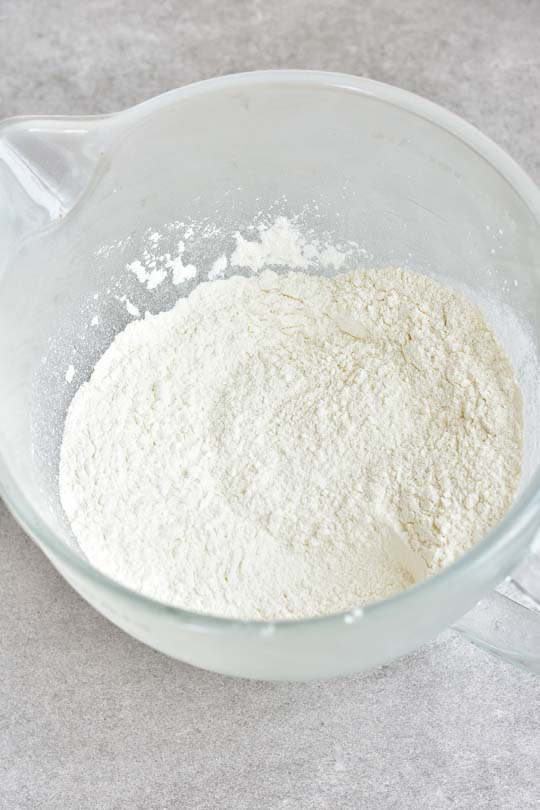
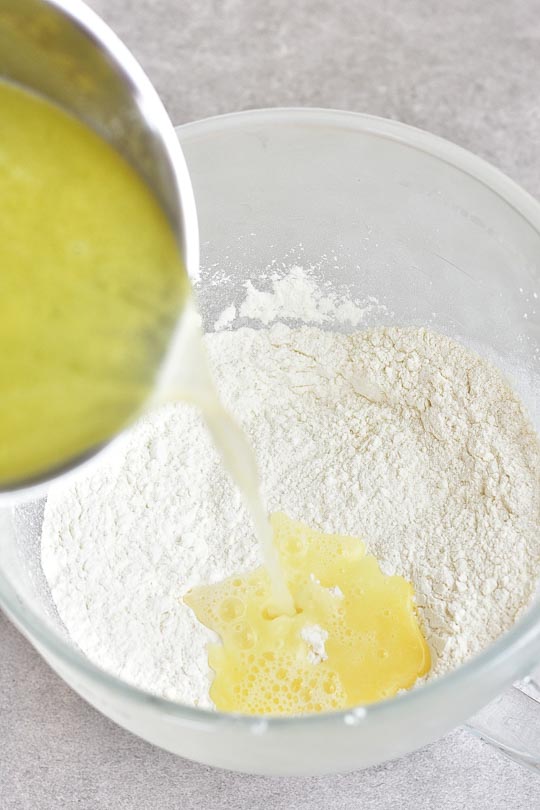


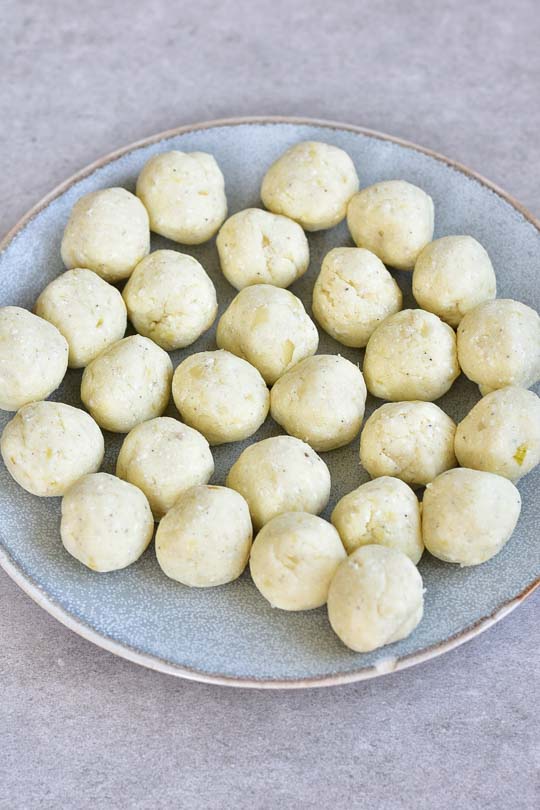
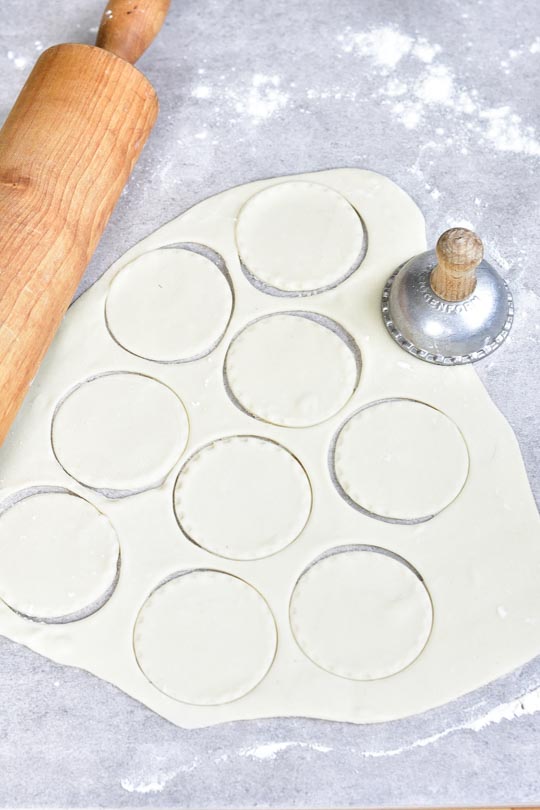
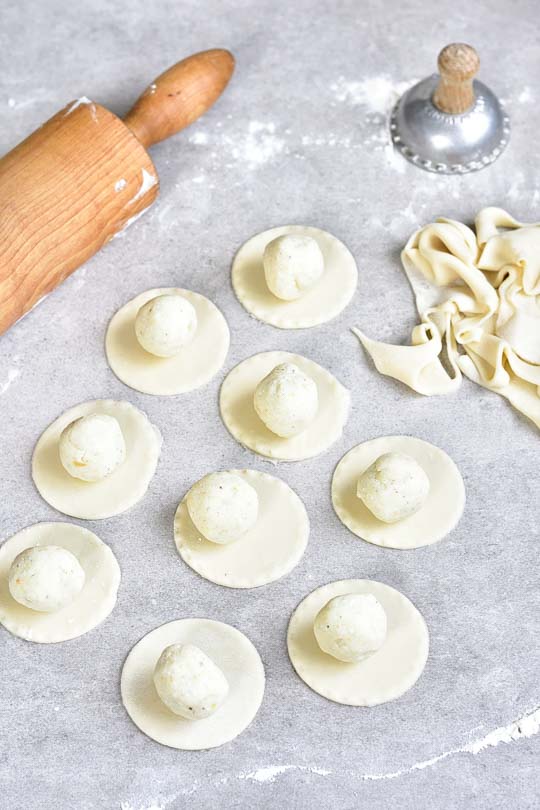
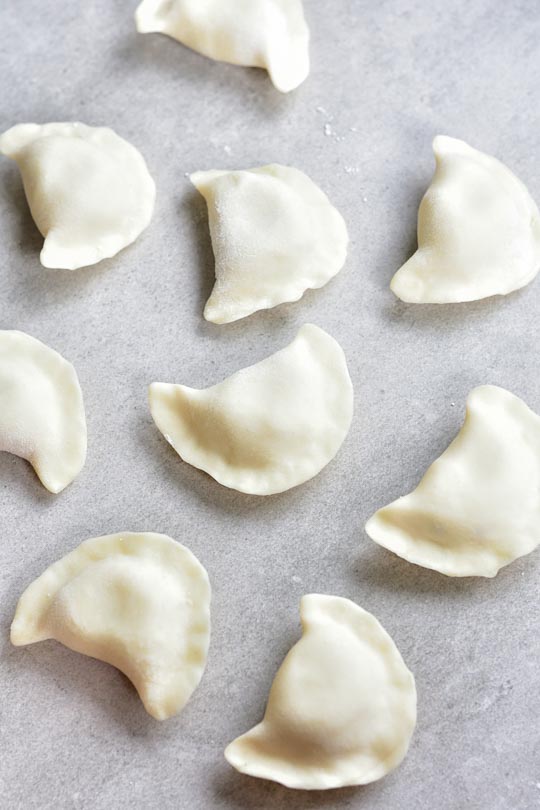
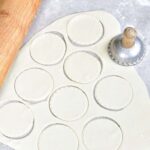


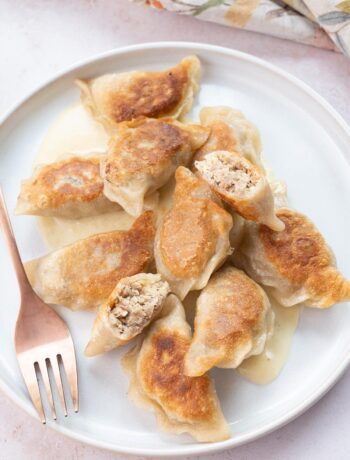
391 Comments
Eric
27 December 2023 at 21:06Recipe sounds great my father when making his dough one ingredient I always remember was baking powder why would that help or hurt your dough recipe?
Aleksandra
27 December 2023 at 21:29This is quite an unusual ingredient for pierogi dough. Baking powder is usually used to make dough more fluffy and this is in my opinion not needed for pierogi dough. I wouldn’t add it but I also don’t think it would hurt that much. If you grew up eating this kind of pierogi dough, you will probably like it! Experiment with the ingredients and let us know how it worked for you.
Roger Drenga
21 December 2023 at 12:41I have been using your recipe for 3 years. By far the best ever. dough
rolls out so smooth. I’m so happy I found this recipe. Has made my
pierogi making easy.
Aleksandra
21 December 2023 at 13:41I’m so happy to hear that, thank you for leaving the comment!
Trish
22 December 2023 at 18:35Can I use plant based butter when making the dough?
Aleksandra
22 December 2023 at 20:07Other readers have already reported that it works. You can also use any vegetable oil.
Judy M
26 October 2023 at 00:38I’ve been making perohay for 50 years and now use only your recipe (sorry mom). I roll the dough in my macaroni machine and it turns out perfect. No more floured kitchen counters. My count is approximately 130 as I make them quite small. Thanks for making my life so much easier.
Aleksandra
26 October 2023 at 07:15You’re welcome! I’m happy it worked well for you.
Diane Uhls
8 November 2023 at 21:58I’ve been making periogi’s for a long long time. I have always had to alter my recipe each time to the touch. I was eager to try your recipe and see if I’d like it. Well you got a 10 star! I weighed everything and it was perfect. What was wonderful that that my husband, daughter and her boyfriend helped. The guys loved making the dough and with them weighing everything I knew it would be fine. The dough rolled out soft and easy. Scraps were put back into a bag to rest and they were also easy to reroll. I can’t wait to share this recipe with my mom. She will love it too. I got a new periogi press that I also tried that I absolutely love. All my periogi’s looked perfect and uniformed.
I had extra dough that I used up the next morning when I made more filling and it was just as good as the night before. Thanks so much for sharing! I have 150 frozen and ready for Christmas.
Linda
15 October 2023 at 21:20I’m tossing my previously used dough recipe and replacing with this one! So much easier to handle! Pierogis are tender and delicious. Thank you for posting this recipe!
Aleksandra
16 October 2023 at 14:01you’re welcome! I’m glad it worked well for you!
Danielle
1 October 2023 at 14:07Where did you get your electric potato masher. I looked around and can’t find the same one. Thanks in advance.
Aleksandra
1 October 2023 at 14:49mine comes from this hand blender set: https://www.amazon.com/Braun-Multiquick-Blender-Blending-Chopper/dp/B097GRQ1S5/
Shelley
19 October 2023 at 22:04This is an absolutely perfect pierogi dough recipe. It was a pleasure to work with. Used my scale for accuracy & my KA pasta roller. Thanks for posting!
Aleksandra
20 October 2023 at 14:37you’re welcome! I’m glad it worked wwll for you!
Jessie
27 September 2023 at 20:40This is hands down the easiest pierogi dough I’ve ever worked with and it cooked perfectly. Thanks for all the tips and tricks, too
Aleksandra
28 September 2023 at 16:20you’re welcome! happy to help and thank you for leaving the comment
Cher
27 September 2023 at 16:02Absolutely delicious! So few ingredients. So easy to follow! Freshest, yummiest pierogis! I struggled at first with the stuffing and sealing part (I wanted a lot of filling) so my first 5 or six looked quite hilarious (still tasted good) but I found my groove and the rest looked PRO! I halved the recipe, rolled my dough as thin as I could and using a 3 inch cookie cutter and the second rolled dough scraps, I yielded approx. 30 medium-large sized pierogis. Thanks for this great recipe and all of your tips! I will def. be using this recipe again! Side note, I made these about 3 hours ahead of boiling, covered with a tea towel, and refridgerated until dinner time.
Aleksandra
27 September 2023 at 16:39thank you for letting us know!
Alberta Reiber
4 September 2023 at 18:29Just made your recipe… wow! It’s great! Thank you. Just one question…. Can this recipe be doubled ? Some recipes don’t seem to do so well when doubled.
Aleksandra
4 September 2023 at 19:58you can easily double or triple the recipe
JoeBKS
25 August 2023 at 20:47First time making pierogi and thank you. Great dough recipe. It was easy to work with though it took longer than estimated. It always does the first time. I made a mashed potato and onion filling. I have about 40 pierogi frozen to eat another day. We made it for Ukrainian Independence Day. Slava Ukrani!
Aleksandra
26 August 2023 at 07:14I’m happy the recipe worked well for you!
Anita
14 August 2023 at 02:18Wow for years I’ve been hearing my friend tell me they are so hard to make but this recipe was amazing and easy to follow. I do admit I followed exactly and made the American filling because my husband doesn’t like onions, but all the fillings sound delicious to me because I love that dough. No egg no sour cream works great. I do admit I stumbled on the first batch because I didn’t fill them enough I was afraid I would not get the closing right and they would leak in water but they didn’t the dough was perfect and i adjusted the amount. I loved making them. Way better than frozen stuff from store even the scratch. Everyone loved them so much and I’m so excited that I took the chance to make these, thank you for the recipe and instructions I felt really confident after reading the instructions. So thank you very much. Very kind to share this with everyone online.
Aleksandra
14 August 2023 at 07:39you’re welcome! thank you for leaving the comment!
Heather Chaulk
4 August 2023 at 12:12I have heard of perogies but have not eaten them I cant wait to try this recipe. There is not a big cost for the ingredients and I love that the most. I think we are going to love these Thank you for all the information. It helps greatly to know how to make the dough and how to cook 🙂
Aleksandra
4 August 2023 at 20:19you’re welcome! I hope it will work well for you.
Pamela
8 July 2023 at 09:57Super simple, easy to make. Thank you for sharing. Taste exactly like what I was raised on. I just roughly measured with cup measures. I rarely measure when cooking though. I made these stuffed with blueberry filling, and they were quite delicious. My problem is putting to much filling and it coming out when sealing them. But spot on goodness with this recipe. Thanks
Aleksandra
8 July 2023 at 13:56My tip for the blueberry filling is to freeze the blueberries first, then they won´t leak as much while sealing the dough. I´m glad you liked the recipe!
Sarah
8 May 2023 at 10:08I made this recipe twice and it turned out perfectly both times and I had never made pierogi. I read all the tips and followed them including weighing my ingredients which is my preference as it is more accurate. I did use a different filling as my family likes a potato/bacon/cheese mixture. The dough melts in you mouth. Also I pan fried after boiling as that is my families preference.
I am sure with time I will get faster but I must say I have a new appreciation for the ladies that makes and sell 1000s of pierogi for the church. Thank you so much for putting this together and sharing it.
Aleksandra
8 May 2023 at 16:07Thank you for such an amazing comment. Your pierogi look amazing, I wish I could try them right now!
Natasha
19 June 2023 at 00:32This was the perfect recipe for our pierogies. I weighed the ingredients and doubled the recipes. Instead of rolling out the dough I pinched off the dough and made balls and flattened with my tortilla press. It was the fastest I’ve ever made them.
Aleksandra
19 June 2023 at 13:55great idea to use a tortilla press!
daniel lukensow
23 April 2023 at 23:16THESE RECIPES ARE ABSOLUTELY MARVELOUS. I CAN JUST LOOK AT THE PHOTO AND TELL THAT THE DOUGH IS SOFT AND TENDER. JUST LIKE THE NUNS DO.!!!
Tanya Frost
9 April 2023 at 01:19Ok I made this and it turned out amazingly perfect. Tried again the next day and it did not work so I thought maybe I did something wrong so I started from scratch and nope, didn’t work the third time. I did everything exactly the same. Not sure why it’s not working ♀️
Aleksandra
9 April 2023 at 06:36can you say what was not working the next day? what was wrong?
Liz Nowak
2 March 2023 at 15:07My mother-in-law passed before any of us were able to get her dough recipe. As a chef, I tried multiple recipes and they just did not work. I found this recipe and then remembered her adding the hot water to her flour and voila! I now can make the dough just as she did. This is the best dough recipe. It is easy and very easy to work with. We love it! Thank you for sharing it.
Aleksandra
2 March 2023 at 16:24you´re welcome! I´m glad it worked well for you!
Emma A.
2 February 2023 at 02:35Today was my first ever solo attempt at making pierogi after watching my late mother and grandmother make them countless times. I didn’t have the family dough recipe on hand, so I looked one up and landed here. This dough recipe is FANTASTIC. Easy to make, easy to work with. I used our family’s cabbage filling recipe. Tasted just like mom’s. I was also delighted to see in your video the beautiful braided edging. My grandmother was an expert in that; me, not so much! Thank you, Aleksandra! I look forward to trying some of your filling recipes. 🙂
Aleksandra
2 February 2023 at 07:20Thank you so much! I´m happy the recipe worked out for you!
Jen
23 January 2023 at 02:37this dough is amazing to work with! it rolls out so nicely (I used my kitchen scale to weigh the flour) and the edges pinch together so easily. This will be my go-to pierogi dough recipe from now on
Aleksandra
23 January 2023 at 07:18I´m glad to hear that. Thank you for leaving the comment!
Joanne Morgan
7 April 2023 at 21:51They came out, great for my first time making then just had hard time rolling out even after resting dough for almost an hr. Next time will weigh flour and buy a attachment for my KitchenAid mixer and a new cutter and mold. Thank you for this recipe!
Lesley
7 January 2023 at 14:34Hello Aleksandra, just did this today. I used pork and beef mince with cabbage, carrots, onion and no flavorings. I did not cook the meat first and next time I will. They were delish, easy to make and filling. The dough was easy and worked well. Love them. Thankyou for an easy to follow recipe woth so much info it made it really work.
Aleksandra
7 January 2023 at 15:20I´m glad to hear that, thank you for leaving the comment!
Marcia Balleweg
30 December 2022 at 02:51I love your recipe and found using the scale much better than using cup measurements. However, I could not re-roll the scraps after my initial roll. They dried out really fast and the dough would shrink right away. Do you have any suggestions?
Aleksandra
30 December 2022 at 16:53What I do is I roll out the first half of the dough, cut out rounds, wrap the scraps tightly in plastic foil so they won´t dry out. Then I roll out the remaining dough, cut out rounds. Combine the scraps and roll them out together. Scraps will always be harder to roll out unless you leave them to rest again for 15-30 minutes. There are not that much scraps so I don´t mind that much that they are a little bit harder to roll out. A silicone rolling mat is excellent for rolling out the dough. Many readers also mentioned that they like to roll out the dough using KitchenAid pasta attachment but I personally I´m not a fan. I hope this helps.